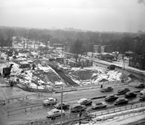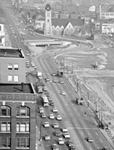
The Automobile Shapes The City
Modifying the City Core
More paving of streets in cities meant roads designed expressly with a variety of vehicles in mind. Building hard-surface streets began in the late-nineteenth century to serve the needs of bicycle-, wagon-, and carriage-transportation, and into the twentieth primarily for faster and heavier motorized vehicles. Macadamized roads—built with a multilayered surface of crushed stones—could not withstand automobiles and rutted badly under their tires. Roads and streets made of concrete and asphalt were more suited to automobiles and eventually became the surfaces of choice. Automobiles not only affected roadbuilding technology, however, but the social life of cities as well. It was becoming much less safe to gather in the streets without the protection of a vehicle, to let children play their games in what passed for an early playground, or to extend a front-porch culture into a road abutted by several neighboring houses. The use of the streets as social and recreational gathering places was threatened and indeed supplanted by the requirements of increasingly rapid and mounting vehicular traffic. In newer communities, especially, pedestrian street activity was restricted to pedestrian precincts and paths and to shopping plazas and malls.
After World War II especially, the traditional city street was replaced by a number of specialized roads, including collectors, distributors, arterials, by-passes, relief roads, ring roads, highways, expressways, and motorways. The first highway to be designed exclusively for the use of cars—the Bronx River Parkway—was completed in 1906, but it was not fully opened for traffic until 1924. Possibly the exploits of Robert Moses in New York best illustrated the rise of the urban highway. Moses was responsible for almost every major highway in New York City, including the Long Island Expressway that was influential in encouraging suburban sprawl directly linked to automobile use. A well-functioning street and highway system was necessary to accommodate automobiles and other motorized vehicles traveling at a variety of speeds to a variety of locations in a variety of numbers. But once expressways and limited-access highways were added to the mix, cities were further committed to a one-dimensional transportation system with infrastructural and environmental implications.
The addition of new roadways was most often limited to big cities—over 150,000 in population—until quite recently and initially made up a small percentage of the total surface transportation network. Over time, highways capable of accommodating greater volumes of traffic required an expanded network, not only in the number of roads, but in the expansion of highways into four, six, eight or more lanes. The new roads, streets, and urban highways had an impact on city life well beyond their individual physical presence. The agglomeration of expressways, inner loops, ring roads, by-passes, and throughways created wheel-like patterns superimposed over the existing grids of many cities, shaping new growth within the core and without. “Like igneous intrusions in sedimentary rocks,” Edward Relph vividly stated, “these cut across the grain of the city with their distinctive landscape textures.” Another expert bemoaned: “Freeways have paid little respect to urban design values. In fact, it can be fairly said that in the design of freeways no attention at all has been paid to their impact on the image of the city. Views have been obliterated, important landmarks have been isolated, great waterfronts have been cut off, all by freeways within the cities whom they supposedly serve.” He added, “the confrontation between the freeway and the city involves an encounter between motion and static mass.” Others, however, give priority to practical matters—ease of mobility for example—over urban aesthetics and argued that the need for quick and efficient transportation supersedes appearance. While attempting to reduce congestion on local roads and improving access to the core districts, however, new urban street and highway systems have helped to make cities different places than they once had been, places where the needs of automobiles often supersede the needs of almost everything else.
Some have blamed not only the transformation but the destruction of core cities on automobiles. This is an extreme position that does not take into consideration the impact of various social, economic, technical, and political variables that all contributed to decaying cores and thriving suburban and peripheral development in American metropolises. Even the best known critic of the demise of American city cores, Jane Jacobs, has noted, “Automobiles are often conveniently tagged as the villains responsible for the ills of cities and the disappointments and futilities of city planning. But the destructive effects of automobiles are much less a cause than a symptom of our incompetence at city building.” The policies imbedded in “urban renewal” of the 1950s and 1960s, for example, incorporated highway building into plans for urban redevelopment and slum clearance, but the needs to improve mobility did not initiate urban renewal nor justify it.
To suggest that the automobile had an insignificant role in urban decay and the suburban explosion is also naïve and ahistorical. Constructing a highway or freeway through an existing neighborhood, by its very act disrupted, degraded, and in some cases destroyed a community. Property values plummeted, but more significantly people were displaced and their neighborhood attachments undermined. One person’s blight and slum clearance was another’s life ripped asunder.
The expansion of the nation’s road system after World War II with federal highway construction as a major force not only led to a sweeping interstate highway network, but left a major imprint on cities. In 1947, Congress authorized a national highway network of 37,000 miles, of which 3,000 miles of roads were to be built in or near 182 major cities. This began a process that would help to redefine downtown areas as commercial centers accessible to suburban communities. By the time of the enactment of the key piece of legislation to extend the interstate system—the Interstate Highway Act of 1956—there already were 376 miles of freeways in the twenty-five largest cities and at least 100 more miles under construction. While the 1956 act was primarily intended to improve intercity travel and did not mention its broad impacts on urban areas, its supporters hoped it would ease downtown congestion. Its impact on cities was much greater than that, however. Within about a decade, $15 billion of the $27 billion spent on highway construction went to urban roadways. Rather than relieving congestion, the new highways increased traffic going downtown and further loaded downtown streets. For their part, the beltways surrounding major cities drew development to them and away from city cores. The impact of the urban interstates and beltways—such as the Capital Beltway around Washington, D.C.—was to clear low-income properties in line with the general goals and objectives of the urban renewal project, but in so doing viable neighborhoods were divided, the residential function of city centers was weakened, urban housing stock was reduced, and the situation was made worse for the poor and the disadvantaged.
<<Previous Section - Next Section>>
Introduction
The “Footprint” of the Automobile on the American City
From “Walking Cities” to “Automobile Cities"
Modifying the City Core
Filling Stations and Other Services
Expressways, Freeways, and Superhighways
Complete Text Printable View
About the Project | Credits | Contact Us | Student & Teacher Resources | Site Map
©2004-2010 Automobile in American Life and Society


